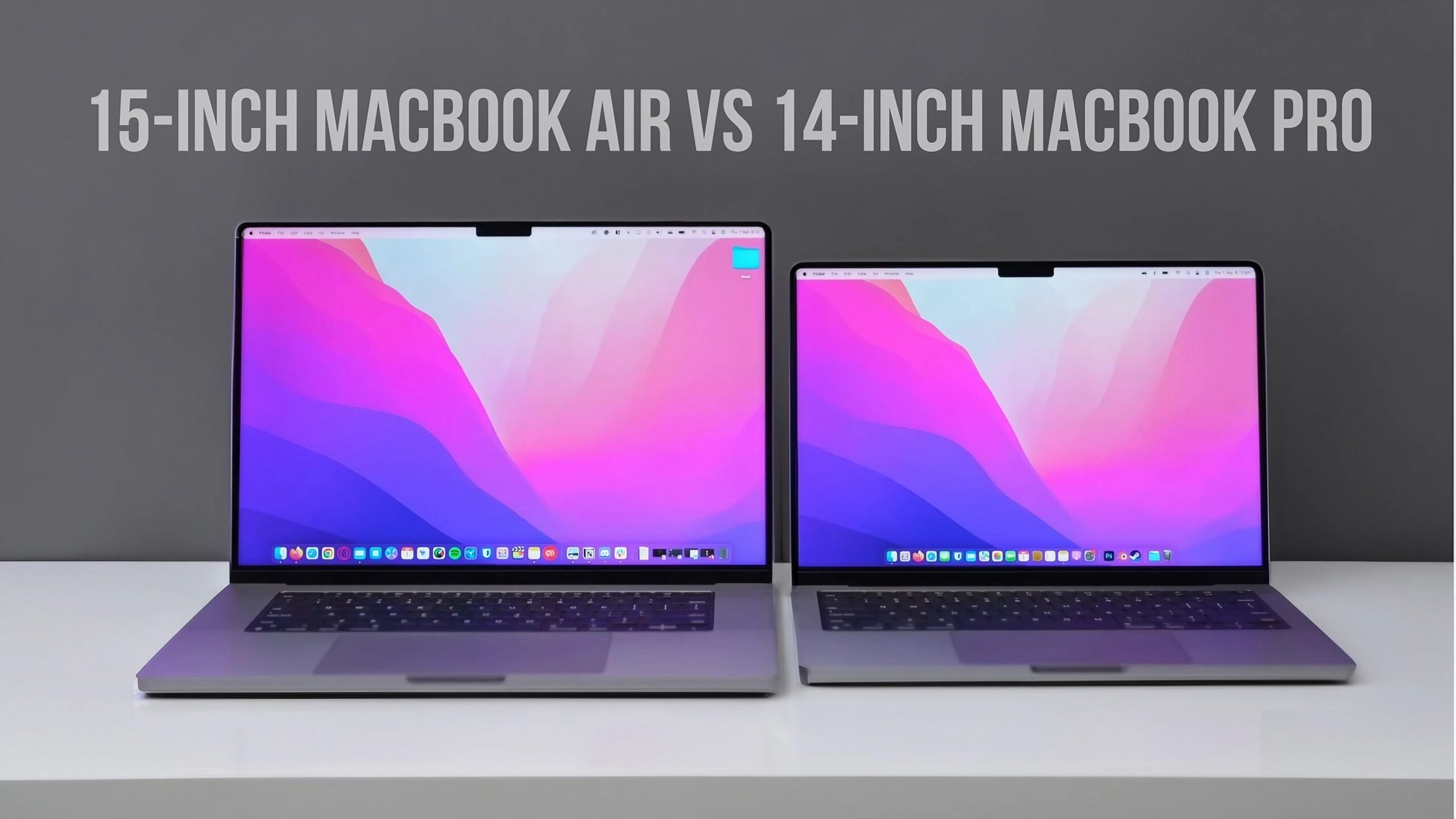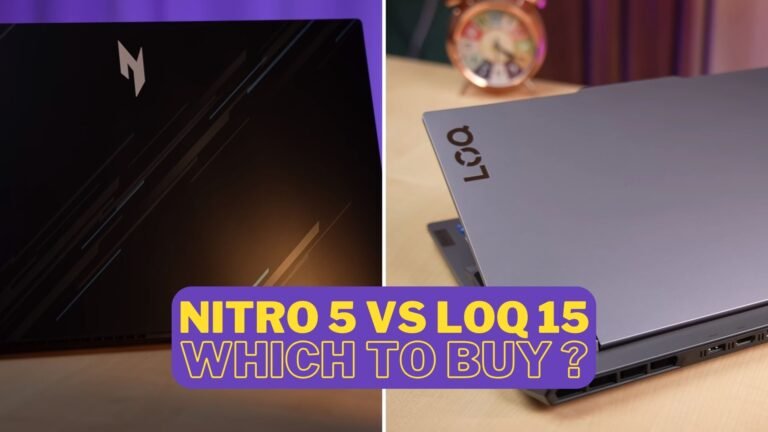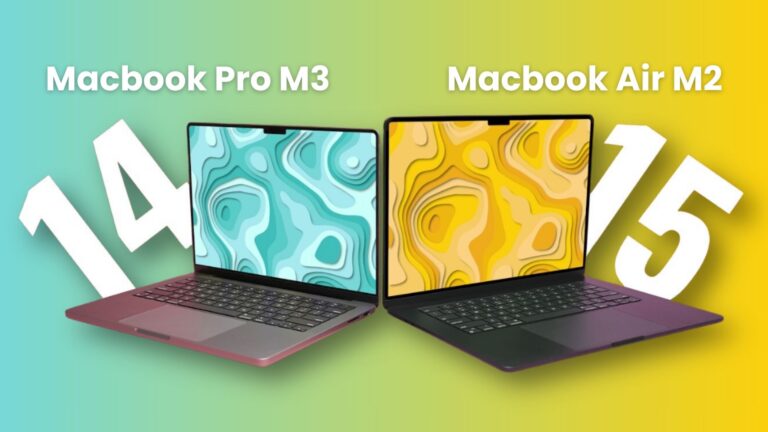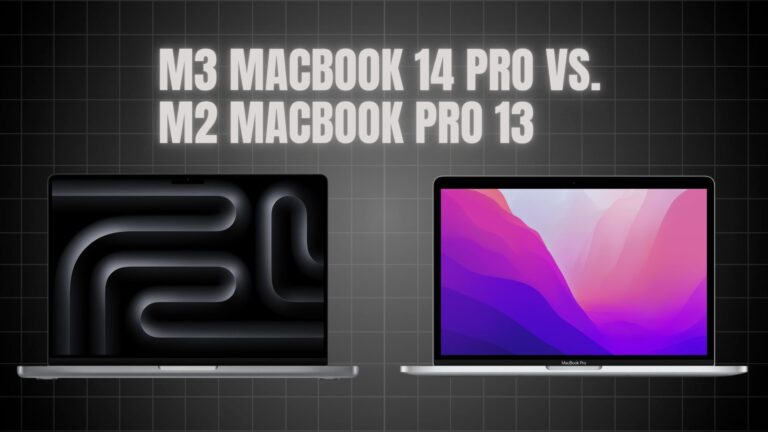Apple made things a little confusing with the 15-inch M2 MacBook Air. When you first look at it, $1299 is an incredible value for a super thin, light and powerful 15-inch MacBook. But once you start adding unified memory and internal storage doesn’t make sense even for the everyday user to go with a 14-inch MacBook Pro.
| MacBook Air 15-inch (2023) | MacBook Pro 14-inch (2023) |
 |  |
| Check Amazon | Check Amazon |
| PROS | PROS |
| Big screen Slimline design Good price | M2 Pro and M2 Max chips Near 20-hour battery Excellent screen |
| CONS | CONS |
| Same internals as a 13-inch Less portable | Expensive Price rise for UK and Australia |
Design

Both laptops share a similar boxy design, with the MacBook Air being slightly larger in size and the MacBook Pro weighing approximately 90 grams more and having a slightly thicker profile. In terms of portability, they are closely matched unless your bag cannot accommodate the larger size of the 15-inch Air.
When it comes to ports, there are critical differences affecting performance and user experience. The MacBook Air features 2x Thunderbolt 3/USB 4 ports, an Air MagSafe port on the left side, and a 3.5-millimeter headphone jack on the right.
In contrast, the MacBook Pro offers 2x Thunderbolt 4 ports, a MagSafe port, and a 3.5-millimeter headphone jack on the left, along with an additional Thunderbolt port, an HDMI port, and an SDXC card reader on the right.
Both laptops support data transfer speeds of up to 40GB/s, but the MacBook Pro has an advantage with the extra port, although most users can manage with two ports, especially considering the convenience of the MagSafe port for charging.
The MacBook Air has all three ports on the left side, limiting you to charging and connecting accessories from one side. On the other hand, the MacBook Pro’s ports on both sides provide more convenient access whether you’re traveling, at a coffee shop, or at home.
Additionally, the MacBook Pro is superior in terms of external display support. The MacBook Air can handle a single external display of up to 6K at 60 hertz. In contrast, the MacBook Pro with the M2 Pro chip supports 2x 6K displays at 60 hertz each, and with the M2 max chip, it can handle 3x 6K displays at 60 hertz along with an additional 4K display at 144 hertz. This makes the MacBook Pro a better choice for users who require multiple high-resolution displays without the need for additional adapters or hubs.
Display

Let’s delve into the displays of these laptops. The MacBook Air boasts a 15.3-inch display, whereas the MacBook Pro features a slightly smaller 14.2-inch screen. Surprisingly, the MacBook Pro manages to incorporate thinner bezels despite its smaller size.
When it comes to the actual display quality, the liquid retina XDR display on the MacBook Pro takes the lead. Although the 15-inch display on the Air is undoubtedly impressive, but the MacBook Pro’s screen stands out with its exceptional sharpness. The colors are incredibly vivid and crisp, a result of its mini LED display technology. This is a notable advantage over the LCD display found on the MacBook Air, providing richer dark blacks due to a greater number of dimming zones.
Interestingly, even though the MacBook Pro has a smaller physical size, it boasts a higher resolution. However, an intriguing aspect is how scaling impacts the user experience. Surprisingly, the MacBook Air can display more of a webpage compared to the MacBook Pro.
Both laptops offer a maximum brightness of 500 nits for SDR content. However, the MacBook Pro goes a step further by reaching 1000 nits for sustained full-screen brightness and an impressive peak brightness of 1600 nits for HDR content. This disparity becomes particularly noticeable as HDR content gains prevalence over standard SDR content.
In terms of color support, both displays are equipped with P3 technology, covering a range of 1 billion colors. However, a key distinction lies in the refresh rates. The MacBook Air features a 60Hz display, while the MacBook Pro introduces ProMotion. Apple’s ProMotion technology dynamically adjusts the refresh rate between 24Hz and 120Hz based on what you’re doing. This optimization enhances the user experience and contributes to extending battery life.
Keyboard & Trackpad

Let’s now discuss the keyboard and trackpad, both of which are consistent across both devices. The keyboard featured on both laptops is truly exceptional and ranks among the best I’ve encountered on any laptop. It offers a comfortable typing experience with keys that exhibit a satisfying amount of tactile feedback. Notably, a complete row of function keys is present, and the inclusion of a touch ID button adds a layer of convenient biometric authentication.
Turning our attention to the trackpad, it’s worth noting that Apple is renowned for producing one of the finest trackpads in the market. The trackpad is remarkably responsive and highly accurate, allowing for clicks anywhere on the surface. An interesting observation is that the 15-inch MacBook Air comes with a slightly larger version of this outstanding trackpad.
Cameras & Speakers
Regarding the cameras, both MacBooks are equipped with Apple’s modern 1080P camera, which performs exceptionally well during video calls. It’s important to note that both laptops feature a notch. However, a notable absence is the Face ID feature, which many users, including myself, would have appreciated.
Shifting our focus to the speaker systems, both MacBooks are furnished with a six-speaker sound system that includes force-canceling woofers. In the case of the MacBook Air, the speakers are cleverly concealed within the hinge, while the MacBook Pro adopts the more conventional approach with speaker grills positioned on either side of the keyboard.
Apple has labeled the sound system on the MacBook Pro as “High Fidelity.” Although the speakers on the MacBook Air deliver surprisingly impressive sound quality, especially given their inconspicuous placement, they do fall short compared to the MacBook Pro’s sound system in terms of sheer quality.
The audio experience on the MacBook Pro is notably richer and warmer, exuding a greater sense of presence. If you prioritize the quality of the speakers on your MacBook, then opting for the 14-inch MacBook Pro would be the preferred choice.
Performance
If you’re looking for the more powerful machine obviously you know that’s the MacBook Pro whether you go with the M2 Pro or the M2 Max and that’s because of the additional CPU and GPU cores. But the MacBook Air has plenty of power for the vast majority of users.

Since the foundation of all three chip variations is the same, single core performance is virtually identical.

When we look at multi-core performance, as you’d expect the MacBook Pro comes out ahead and by how much really depends on which configuration of the MacBook Pro you go with.

For GPU performance, again, you’d expect the MacBook Pro to come out ahead and it does.
Another notable advantage exhibited by the MacBook Pro pertains to its sustained performance. This is attributed to its active cooling system, which employs fans. When the system encounters intensive tasks leading to increased heat, the MacBook Pro can activate its fans to efficiently cool down the system, thus preserving consistent performance levels.
Evidence of this can be observed when subjecting the system to a prolonged workload at 100% capacity for a duration of 30 minutes. In this scenario, the MacBook Pro sustains its performance at a similar level to the initial baseline test, demonstrating the efficacy of its cooling mechanism. In contrast, the MacBook Air lacks fans and consequently, it must resort to throttling its performance to manage heat. This results in a performance reduction of around 7.7%.
Beyond enhanced performance, the MacBook Pro boasts double the memory bandwidth compared to the MacBook Air. Moreover, a significant distinction arises concerning unified memory. The base configuration of the MacBook Air is equipped with 8GB of memory, which can be elevated to 16GB or 24GB. Conversely, the MacBook Pro starts with a base memory of 16GB, and its upgrade options extend to 32GB, 64GB, or an extensive 96GB. This wider range of memory configurations in the MacBook Pro offers a more versatile and future-proof solution for users with varying needs.
Battery Life
The MacBook Pro boasts a slightly larger battery with a capacity of 70 watt-hour, whereas the MacBook Air is equipped with a 66.5 watt-hour battery. Despite this discrepancy, both laptops are rated for 18 hours of video playback. Notably, the MacBook Air is rated for 15 hours of wireless web browsing, whereas the MacBook Pro offers a slightly shorter duration of 12 hours for the same task.
Based on my personal experience using both laptops in my daily routines, I typically find myself needing to recharge them every other day or even every three days. However, the actual battery life varies depending on the nature of my tasks. For light usage scenarios such as web browsing, email, video watching, and basic document editing, the MacBook Air impressively outlasts the MacBook Pro. Yet, when engaging in more resource-intensive tasks like working with software such as Lightroom, Premiere Pro, or Final Cut Pro, particularly during tasks like exporting images or rendering video, the MacBook Pro’s superior efficiency enables it to maintain a longer battery life. This advantage stems from its ability to execute these demanding tasks more swiftly and effectively.
Both laptops are accompanied by chargers. The MacBook Air comes with a choice of either a 35-watt dual USB-C port charger or a more powerful 70-watt single port power adapter. On the other hand, the MacBook Pro includes a 67-watt adapter, which can be optionally upgraded to a 96-watt adapter for a modest additional fee of $20.
Pricing & Conclusion
| 15-inch MacBook Air (M2, 8GB/256GB) – $1,299/£1,399/€1,599 15-inch MacBook Air (M2, 8GB/512GB) – $1,499/£1,599/€1,829 |
| 14-inch MacBook Pro (M2 Pro, 16GB/512GB) – $1,999/£2,149/€2,399 14-inch MacBook Pro (M2 Pro, 16GB/1TB) – $2,499/£2,699/€2,999 14-inch MacBook Pro (M2 Max, 32GB/1TB) – $3,099/£3,349/€3,699 |
Comparing the base models of the MacBook Air and MacBook Pro, there’s a substantial price difference of $700, with the MacBook Air priced at $1299 and the MacBook Pro at $1999. However, it’s important to note the differing specifications. The MacBook Air includes 8GB of unified memory and 256GB of internal storage, whereas the MacBook Pro comes with 16GB of unified memory and 512GB of storage.
To make a fair comparison, if you were to upgrade the MacBook Air to match the memory and storage of the MacBook Pro, you’d need to add $400, bringing the total cost to $1700, narrowing the gap to $300. Keep in mind that post-purchase memory and storage upgrades are not possible, though you can augment storage through external SSDs or cloud solutions. Be sure to account for sufficient local storage for your files and applications.
Right now, everything that comes with the MacBook Air takes up about 35GB of storage, leaving over 200GB of free space. If your intention is to upgrade the MacBook Air to 16GB of memory and 512GB of storage, you must weigh the advantages of a thinner, slightly lighter device with a larger display, more extensive trackpad, and improved battery life against the benefits of a smaller device with a superior quality display, more ports, Wi-Fi 6E compatibility, and enhanced external display support. In this case, the base 14-inch MacBook Pro becomes a sensible consideration, even if you don’t currently require the added performance.
It’s worth exploring refurbished options as well. A 14-inch M2 MacBook Pro can be obtained for $1699, the same price as the upgraded MacBook Air. For those less concerned with having the latest processor, an M1 14-inch MacBook Pro could potentially offer the best value at an even lower cost.






